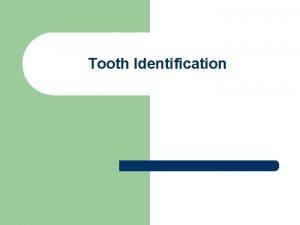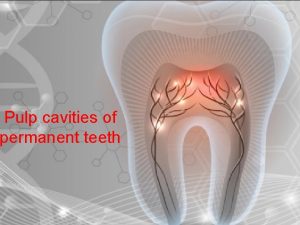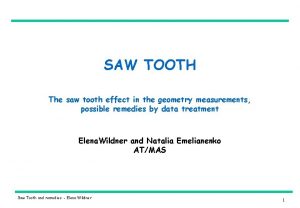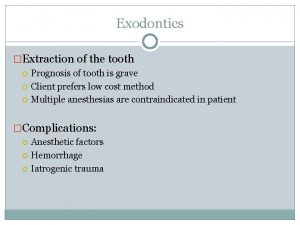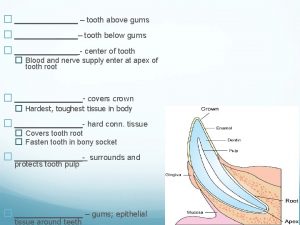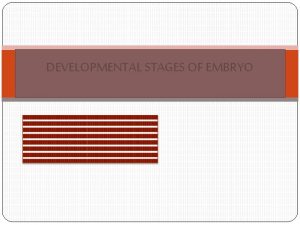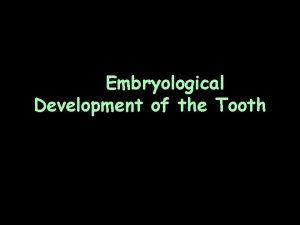DEVELOPMENTAL STAGES The developmental history of a tooth








































- Slides: 40

DEVELOPMENTAL STAGES

The developmental history of a tooth is divided into several morphologic “stages” for descriptive purposes.

While the size and shape of individual teeth are different, they pass through similar stages of development. They are named after the shape of the enamel organ (epithelial part of the tooth germ), and are called the bud, cap, and bell stages.

1 -BUD STAGE: with the differentiation of each dental lamina, round or ovoid swellings arise from the basement membrane at 10 different points, corresponding to the future positions of the deciduous teeth. These are the primordia of the enamel organs, the tooth buds.

The dental lamina is shallow, and microscopic sections often show tooth buds close to the oral epithelium. Since the main function of certain epithelial cells of the tooth bud is to form the tooth enamel, these cells constitute the enamel organ, which is critical to normal tooth development

The area of ectomesenchymal condensation immediately subjacent to the enamel organ is the dental papilla The condensed ectomesenchyme that surrounds the tooth bud and the dental papilla is the dental sac. Both the dental papilla and the dental sac become better defined as the enamel organ grows into the cap and bell shapes.


CAP STAGE: which is characterized by a shallow invagination on the deep surface of the bud The peripheral cells of the cap stage are cuboidal, cover the convexity of the “cap, ” and are called the outer enamel (dental) epithelium. The cells in the concavity of the “cap” become tall, columnar cells and represent the inner enamel (dental) epithelium. The outer enamel epithelium is separated from the dental sac, and the inner enamel epithelium from the dental papilla, by a delicate basement membrane.


The enamel organ may be seen to have a double attachment of dental lamina to the overlying oral epithelium enclosing ectomesenchyme called enamel niche between them. This appearance is due to a funnel-shaped depression of the dental lamina.

STELLATE RETICULUM: Polygonal cells located in the center of the epithelial enamel organ, between the outer and inner enamel epithelia, begin to separate due to water being drawn into the enamel organ from the surrounding dental papilla as a result of osmotic force. exerted by glycosaminoglycans contained in the ground substance.

This gives the stellate reticulum a cushion like consistency and acts as a shock absorber that may support and protect the delicate enamel-forming cells. The cells in the center of the enamel organ are densely packed and form the enamel knot.

This knot projects in part toward the underlying dental papilla, so that the center of the epithelial invagination shows a slightly knob like enlargement that is bordered by the labial and lingual enamel grooves. At the same time a vertical extension of the enamel knot, called the enamel cord occurs.

When the enamel cord extends to meet the outer enamel epithelium it is termed as enamel septum, for it would divide the stellate reticulum into two parts. The outer enamel epithelium at the point of meeting shows a small depression and this is termed enamel navel as it resembles the umbilicus.

These are temporary structures (transitory structures) that disappear before enamel formation begins. The function of the enamel knot and cord may act as a reservoir of dividing cells for the growing enamel organ. Recent studies have shown that enamel knot acts as a signaling center as many important growth factors are expressed by the cells of the enamel knot and thus they play an important part in determining the shape of the tooth.

DENTAL PAPILLA: Under the organizing influence of the proliferating epithelium of the enamel organ, the ectomesenchyme (neural crest cells) that is partially enclosed by the invaginated portion of the inner enamel epithelium proliferates. It condenses to form the dental papilla, which is the formative organ of the dentin and the primordium of the pulp.

The changes in the dental papilla occur along with the development of the epithelial enamel organ. The dental papilla shows active budding of capillaries and mitotic figures, and its peripheral cells adjacent to the inner enamel epithelium enlarge and later differentiate into the odontoblasts.

DENTAL SAC (DENTAL FOLLICLE): Is a marginal condensation in the ectomesenchyme surrounding the enamel organ and dental papilla. Gradually, in this zone, a denser and more fibrous layer develops, which is the primitive dental sac.

3 -BELL STAGE: As the invagination of the epithelium deepens and its margins continue to grow, the enamel organ assumes a bell shape. In the bell stage crown shape is determined. The shape of the crown is changed due to the pressure exerted by the growing dental papilla cells on the inner enamel epithelium. This pressure however was shown to be opposed equally by the pressure exerted by the fluid present in the stellate reticulum


. The folding of enamel organ to cause different crown shapes is shown to be due to differential rates of mitosis and differences in cell differentiation time. Cells begin to differentiate only when cells cease to divide. The inner enamel epithelial cells which lie in the future cusp tip or incisor region stop dividing earlier and begin to differentiate first.

The pressure exerted by the continuous cell division on these differentiating cells from other areas of the enamel organ causes these cells to be pushed out into the enamel organ in the form of a cusp tip. The cells in another future cusp area begin to differentiate, and by a similar process results in a cusp tip form.

The area between two cusp tips, i. e. the cuspal slopes extent and therefore of cusp height are due to cell proliferation and differentiation occurring gradually from cusp tips to the depth of the sulcus. Cell differentiation also proceeds gradually cervically, those at the cervix are last to differentiate.

1 -THE INNER ENAMEL EPITHELIUM IN BELL STAGE consists of a single layer of cells that differentiate prior to amelogenesis into tall columnar cells called ameloblasts. These elongated cells are attached to one another by junctional complexes laterally and to cells in the stratum intermedium by desmosomes. .

The cells of the inner enamel epithelium exert an organizing influence on the underlying mesenchymal cells in the dental papilla, which later differentiate into odontoblasts. The junction between inner and outer enamel epithelium is called cervical loop and it is an area of intense mitotic activity

A few layers of squamous cells form the stratum intermedium, between the inner enamel epithelium and the stellate reticulum. These cells are closely attached by desmosomes and gap junctions. Desmosomal junctions are also observed between cells of stratum intermedium, stellate reticulum and inner enamel epithelium. This layer seems to be essential to enamel formation.


3 -STELLATE RETICULUM OF BELL STAGE: The stellate reticulum expands further, mainly by an increase in the amount of intercellular fluid. The cells are star shaped, with long processes that anastomose with those of adjacent cells. Desmosomal junctions are observed between cells of stellate reticulum, stratum intermedium and outer enamel epithelium.

Before enamel formation begins, the stellate reticulum collapses, reducing the distance between the centrally situated ameloblasts and the nutrient capillaries near the outer enamel epithelium. Its cells then are hardly distinguishable from those of the stratum intermedium. This change begins at the height of the cusp or the incisal edge and progresses cervically

4 -OUTER ENAMEL EPITHELIUM OF BELL STAGE: The cells of the outer enamel epithelium flatten to a low cuboidal form. At the end of the bell stage, primary to and during the formation of enamel, the formerly smooth surface of the outer enamel epithelium is laid in folds. Between the folds the adjacent mesenchyme of the dental sac forms papillae that contain capillary loops and

thus provide a rich nutritional supply for the intense metabolic activity of the avascular enamel organ. This would adequately compensate the loss of nutritional supply from dental papilla owing to the formation of mineralized dentin.

DENTAL LAMINA The dental lamina is seen to extend lingually and is termed successional dental lamina as it gives rise to enamel organs of permanent successors of deciduous teeth (permanent incisors, canines and premolars). The enamel organs of deciduous teeth in the bell stage show successional lamina and their permanent successor teeth in the bud stage.


DENTAL PAPILLA IN BELL STAGE: The dental papilla is enclosed in the invaginated portion of the enamel organ. Before the inner enamel epithelium begins to produce enamel, the peripheral cells of the mesenchymal dental papilla differentiate into odontoblasts under the organizing influence of the epithelium.

First, they assume a cuboidal form; later they assume a columnar form and acquire the specific potential to produce dentin. The basement membrane that separates the enamel organ and the dental papilla just prior to dentin formation is called the membrana preformativa.

DENTAL SAC IN BELL STAGE Before formation of dental tissues begins, the dental sac shows a circular arrangement of its fibers and resembles a capsular structure. With the development of the root, the fibers of the dental sac differentiate into the periodontal fibers that become embedded in the developing cementum and alveolar bone.


ADVANCED BELL STAGE This stage is characterized by the beginning of mineralization and root formation. During the advanced bell stage, the boundary between inner enamel epithelium and odontoblasts outlines the future dentinoenamel junction. The formation of dentin occurs first as a layer along the future dentinoenamel junction in the region of future cusps and proceeds pulpally and apically.


After the first layer of dentin is formed, the ameloblast which has already differentiated from inner enamel epithelial cells lay down enamel over the dentin in the future incisal and cuspal areas. The enamel formation then proceeds coronally and cervically, in all regions from the dentinoenamel junction (DEJ) towards the surface
 An eye for an eye a tooth for a tooth sister act
An eye for an eye a tooth for a tooth sister act Maslow vs erikson
Maslow vs erikson Erikson stages of development
Erikson stages of development Kellogg's artistic developmental stages
Kellogg's artistic developmental stages Developmental stage theories
Developmental stage theories Cfam developmental stages
Cfam developmental stages What is psychology
What is psychology Hát kết hợp bộ gõ cơ thể
Hát kết hợp bộ gõ cơ thể Frameset trong html5
Frameset trong html5 Bổ thể
Bổ thể Tỉ lệ cơ thể trẻ em
Tỉ lệ cơ thể trẻ em Voi kéo gỗ như thế nào
Voi kéo gỗ như thế nào Tư thế worm breton
Tư thế worm breton Chúa sống lại
Chúa sống lại Môn thể thao bắt đầu bằng chữ đua
Môn thể thao bắt đầu bằng chữ đua Thế nào là hệ số cao nhất
Thế nào là hệ số cao nhất Các châu lục và đại dương trên thế giới
Các châu lục và đại dương trên thế giới Công thức tiính động năng
Công thức tiính động năng Trời xanh đây là của chúng ta thể thơ
Trời xanh đây là của chúng ta thể thơ Mật thư anh em như thể tay chân
Mật thư anh em như thể tay chân 101012 bằng
101012 bằng Phản ứng thế ankan
Phản ứng thế ankan Các châu lục và đại dương trên thế giới
Các châu lục và đại dương trên thế giới Thể thơ truyền thống
Thể thơ truyền thống Quá trình desamine hóa có thể tạo ra
Quá trình desamine hóa có thể tạo ra Một số thể thơ truyền thống
Một số thể thơ truyền thống Cái miệng xinh xinh thế chỉ nói điều hay thôi
Cái miệng xinh xinh thế chỉ nói điều hay thôi Vẽ hình chiếu vuông góc của vật thể sau
Vẽ hình chiếu vuông góc của vật thể sau Nguyên nhân của sự mỏi cơ sinh 8
Nguyên nhân của sự mỏi cơ sinh 8 đặc điểm cơ thể của người tối cổ
đặc điểm cơ thể của người tối cổ V. c c
V. c c Vẽ hình chiếu đứng bằng cạnh của vật thể
Vẽ hình chiếu đứng bằng cạnh của vật thể Tia chieu sa te
Tia chieu sa te Thẻ vin
Thẻ vin đại từ thay thế
đại từ thay thế điện thế nghỉ
điện thế nghỉ Tư thế ngồi viết
Tư thế ngồi viết Diễn thế sinh thái là
Diễn thế sinh thái là Dạng đột biến một nhiễm là
Dạng đột biến một nhiễm là Các số nguyên tố
Các số nguyên tố Tư thế ngồi viết
Tư thế ngồi viết













































